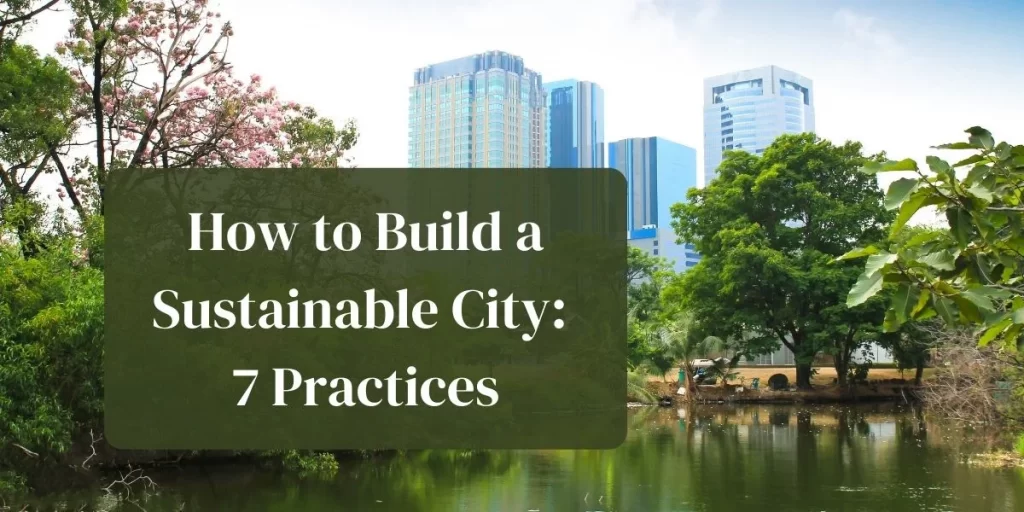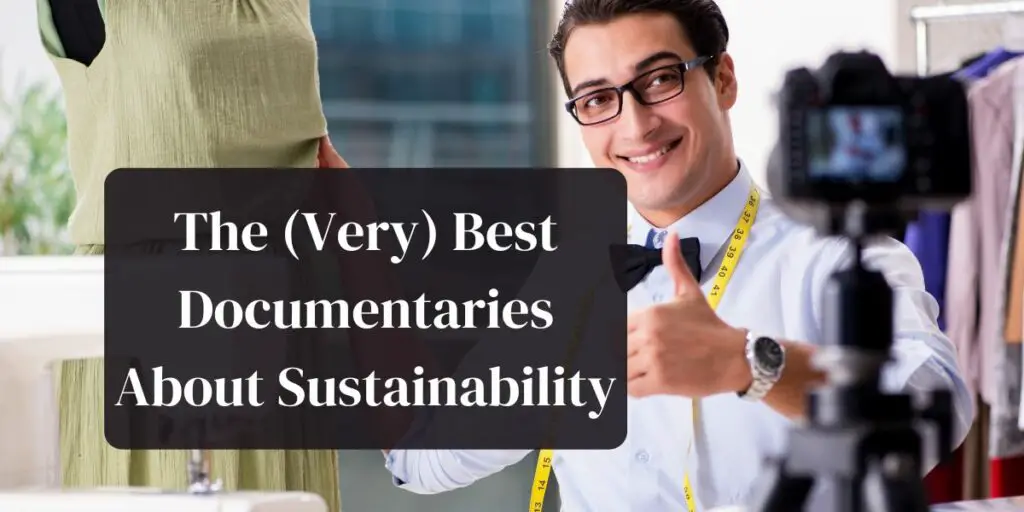Cities on Earth are responsible for 60-80% of energy consumption, which make them prone to the negative impacts of urbanization like pollution, traffic density, gentrification etc. If cities turn into sustainable living places, that can be reversed or mitigated.
Currently, we are facing serious new challenges for survival due to the climate change, so it is crucial to have sustainable cities that create positive social, environmental and economic solutions for us and the future generations.
Living in a safe, pleasant and accessible place requires individual and communal knowledge on how to build a sustainable city that will enhance our everyday life and wellbeing.
Read on to get some ideas of what makes a city sustainable, what we can do to make it more sustainable, plus a few inspirations of today’s cities that are working on becoming more sustainable.
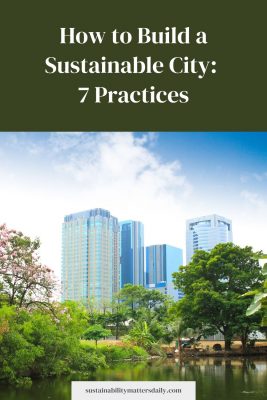
Table of Contents
- The 6 Basic Principles of a Sustainable City
- 7 Practices for Cities that Want to Become More Sustainable
- Top 5 Inspo Sustainable Cities
- Finally…
The 6 Basic Principles of a Sustainable City
According to sustainable urban planning researchers, the concept of a sustainable city relies on several basic principles: green accessible public transportation, renewable energy, waste management, inclusive urbanistic solutions and eco smart technology.
Green Public Transportation
Urban areas need to grow without increasing carbon emissions while stimulating economic growth. Cities focused on sustainability must ensure that their infrastructure can provide easy, cost-and- time-efficient moving around and commuting.
Promotion of green, accessible public transportation and initiatives that put pedestrians and cyclists before cars can improve public transportation, reduce harmful emissions and stimulate more green practices.
Renewable Energy
Initiatives like multimodal transport networks for collective journeys or renewable energy as energy supply in industry and residential areas are just some examples for achieving this. One great example is the city of Dubai which is entirely self-sustainable via renewable energy produced by recycling water and waste (60% of green space irrigated with gray wastewater).
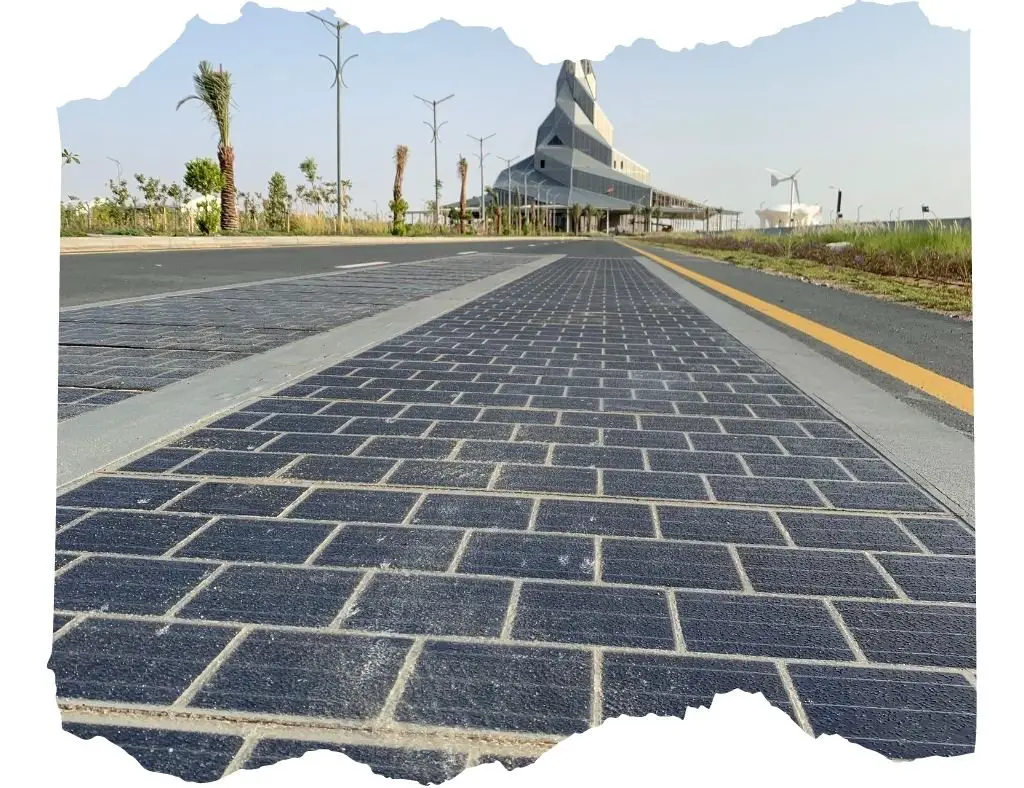
Waste Management & Circular Economy
Next is the waste management. One amazing solution for tackling urban waste is the principle of circular economy, implemented in many Nordic countries.
According to the report of the Nordic Innovation, “designing out waste is a key principle of circular economy initiatives, and Nordic cities are looking to profit from resource efficiency.”
For example, the facades of buildings in Nyborg, Denmark are made of post-consumer paper, and the flooring of glue-free industrial wood boards.
Inclusive Urbanist Solutions
Our cities are made by people, and therefore, they should be FOR the people.
Sustainable cities need to ensure accessibility to public spaces and services, that provide social interaction and safety for citizens. A city that strives to become sustainable should mitigate gentrification and build urbanist strategies that bring people of all backgrounds together. According to activists, tackling single-family zoning and changing taxing owners of vacant properties can protect existing communities within an area and make housing more accessible and affordable.
Access to Nature
Sustainable cities are green, compact cities where citizens have access to nature and use urban spaces in a clever way. The city architecture should bring nature into the city and include the social behaviour of its community while promoting public ownership.
In Singapore, for example, you’ll find Bishan Park, which is a rich ecosystem in the very center of the city. It includes a naturalized river that helps to reduce the so-called “urban hot island effect” and it is a clean, safe spot for people who are out during daytime.
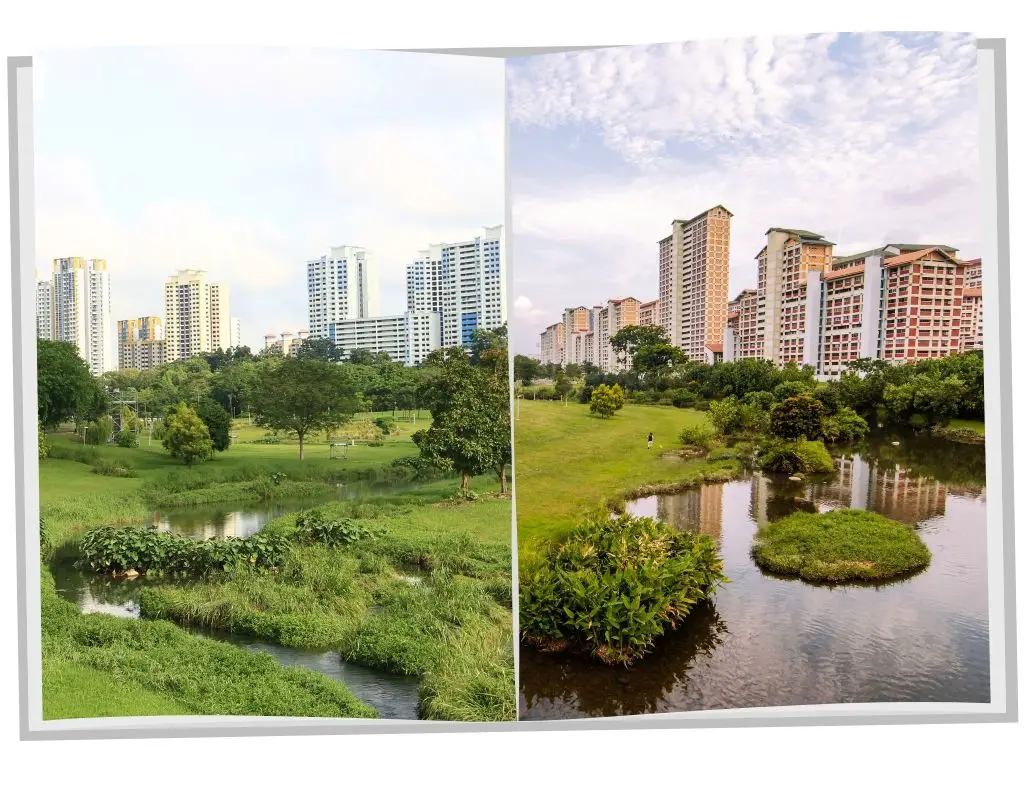
Eco-Friendly Smart Technologies
By using smart technologies, citizens can create platforms to present ideas on how to improve the city or applications that operate eco means for public transport, measurement of air quality etc.
Another great thing in this sector are the revolutionary Electric Vehicle charging stations, also called EV chargers. They supply electrical power to charging plug-in electric vehicles, including hybrids, electric vehicles, trucks, buses, and help to neutralize carbon emissions to a great extent.
The constant expansion of new digital technologies call for transit and upgrading to a smart grid that will respond to future challenges, i.e one that provides communication between the utility and the customers and responds digitally to the rapidly changing electric demands through wide-area monitoring for example, or smart metering infrastructure.
The smart water management provides better understanding of the water system, conservation of water and monitoring of water quality and leaks.
The smart water meter, for example, obtains water consumption at long distance and with a high frequency, providing access to information for customers and water management entities that can control leakage and water volumes overall.
Here is an example of the city of Copenhagen, Denmark, that levels up to these standards with a vision to become carbon-neutral by 2025:
7 Practices for Cities that Want to Become More Sustainable
Changing a city from traditional to sustainable, requires systemic changes that must be supported by citizens, city authorities and businesses that will develop new ways to sustain and increase the potential of their environment.
Now, let’s look at this short “to-do list“ for every future sustainable city:
1. Make It Easy to Get Around Without A Car
As motor vehicles are responsible for the greatest deal of carbon monoxide pollution, cities should focus on creating public transport that will include metro systems, electric trolleybuses and underground railways.
An excellent example of this is the city of Ljubljana, Slovenia, which is one of the few European cities that made its center car-free and provided underground parking lots outside, putting pedestrians before personal vehicles.
A sustainable city understands the importance of going transit-free as much as possible by attacking up carbon-free alternatives, like building cycling tracks and highways that connect the city and make the urban infrastructure easily accessible.
42% of the residents in Copenhagen, for example, bike to work and there are more bicycles than cars altogether. Of course, this hasn’t always been the case, but the persistent Copenhageners managed to call forth the local government to create a bike culture and adapt the future urban planning.
2. Provide Diverse Housing and Locate Important Destinations Near Homes
Research on environmental gentrification have shown that urban communities that are designed and developed for only one housing type and one level of income cannot promote racial and income diversity and add to transportation and infrastructure problems.
When the poor and more vulnerable populations are displaced from newly improved neighborhoods into worse environments, they become additionally burdened while the positive green initiatives remain accessible only to affluent populations and therefore, have limited impact on the environment.
In addition, living in sustainable neighborhoods means creating walkable neighborhoods where important every day destinations like schools, shops, bust stops, clinics etc are at a walking distance, i.e., 10 minutes away from homes.
Walkable neighborhoods are nonetheless important for creating a feeling of community and combatting loneliness, as they enhance interaction and civic engagement.
Watch this short explanation about how the city of Paris, France, plans to become a 15-Minute City:
3. Make Public Green Spaces and Resources Accessible
One of the key elements of sustainable cities is the access to nature and resources related to sport, recreation and leisure activities.
The eco designing of urban landscapes and infrastructures can provide more access to public resources like parks, walking or cycling tracks or nature preserves. Urban green spaces are important for reducing the temperature, i.e., providing the so-called urban green space cooling effect and producing fresh air. These green spaces are sanctuaries in concrete jungles, as they make urban centers more pleasant and have positive impact on the mental health of citizens.
4. Switch to Clean Energy and Green Buildings
Buildings produce 25% of world’s greenhouse gas emissions, and therefore, a sustainable city should opt for the so-called “green building construction”.
These rely on natural materials, include smart heating and cooling systems and solar panels, and can significantly reduce carbon emissions.
To become more sustainable, cities should consider things like planting more shade trees but also investments in solar farms, for example, to provide renewable energy, improve air quality and stimulate economic growth.
Solar farms that are city-funded provide access to solar energy and allow citizens and municipal buildings to transit to renewable energy.
Since 2015, the city of La Paz, Mexico is aiming to become a 100% renewable-powered city although it began with only one solar power plant that provided 64% of the power requirements for the city.
5. Enhance Local Food Production Through Urban Farming
Urban farming and local growing of food can enhance many aspects of life in cities – growth of local economy, improving low food security, reducing the environmental impact of food transportation.
Also, urban farming means growing food on rooftops, in communal and vertical gardens but also in the gardens of schools, hospitals or restaurants, meaning it makes urban spaces more vibrant and multipurpose.
Take Paris, where a small saffron production business is thriving on the rooftops of the metropolitan city. As one of the owner says, “It’s like magic. When you put people’s hands in the soil, everyone’s stress goes away and everyone starts talking. That’s the magic of urban farming.”
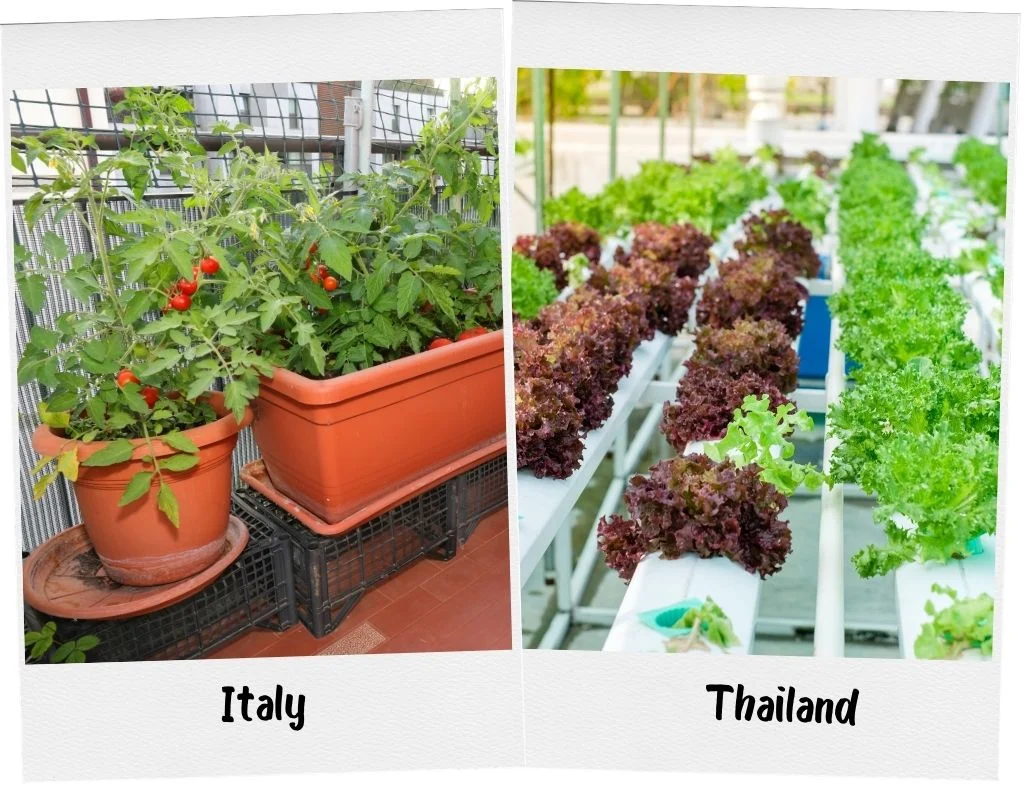
6. Improve Waste Management
To reduce waste, cities should focus on sustainable waste management, i.e., the circular economy model upon which they can develop programs to minimize waste through the popular core waste management practices: recycling, composting and repurposing.
The UK city of Leeds recycles around 40% of waste annually, collected from its 346,000 households. Its recycling system relies on a unique on-street waste management service that has appointed 186 recycling points across the city and even elevated the number of people who recycle from 17% to 49%.
Another great example is San Francisco, where recycling and composting is mandatory by law for all businesses and residences.
Read how Shanghai, China, is trying to become a more sustainable city.
7. Add Vehicle Charging Stations
As all sustainable cities are hoping to become carbon-neutral, stations for charging electric or hydrogen-powered vehicles should be a must.
A regular city vehicle produces around 4.6 metric tons of emissions per year, while the electric one produces none.
Cities should invest in the work of urban planners and developers who can join together, and maybe include private investors, to map out the necessary city spots where the charging stations will be installed in favor of drivers and residents.
Good examples of cities who are advancing toward increased usage of renewable energy and electric vehicles to counter traffic congestion are Los Angeles and New York.
Here are some extra ideas for building sustainable cities, from a TED Talk of Peter Calthorpe:
Learn how to make your home more sustainable here.
Top 5 Inspo Sustainable Cities
Last, but not least, let’s look at some cities which lead by example:
5. Dubai, United Arab Emirates
Dubbed as “the world’s most improbable green city”, Dubai has long been associated with oil, luxury, skyscrapers and artificial islands.
However, Dubai is seriously changing and becomes a sustainable home of its residents. The city is building a giant solar power plant in the desert that will produce cheap and clean electricity. The current leadership is working on making Dubai the city with the smallest carbon footprint by 2050, getting 75% of its energy from clean sources.
4. Berlin, Germany
Berlin is one of the most eco-friendly cities in the world, which is really inspiring considering the population of 3.47 million.
The story goes that after WWI, residents of the German capital began a trend of self-sufficiency, which considered growing their own food and protecting green spaces. Nowadays, Berlin has 400 electric vehicle charging stations and promotes car sharing for daily transits.
Read more about environmental activities of Germany.
3. Cape Town, South Africa
Cape Town is a city that has shown a rapid and structured environmental development through use of new technologies since 2008.
The city began using wind farms for energy and is promoting an outdoor lifestyle for its residents by investing in solar panels, urban farming, safe-cycle routes and a service that allows people to take bikes on buses.
2. Gothenburg, Sweden
Sweden’s second-largest city has been declared as the most sustainable destination in the world for 3 years in a row.
In the past, Gothenburg was an industrial port town but with a bit of political effort and community engagement, it became a sustainable city. It has electric trams and buses that can take you to a free public sauna and poll where changing rooms are made of recycled bottles.
In 2020, it was named a European Capital of Smart Tourism by the European Commission.

1. Ljubljana, Slovenia
The Slovenian capital is a true eco-inspo from Central Europe. It was the first European capital which adopted the so-called Zero Waste Goal by the EU, back in 2014, although it didn’t even have its own waste collection system in the early 2000s.
Today, it has a policy for waste selection, so every household has bins for paper and packaging, which made the recycling rate go from 29% to 68% in 2019.
Finally…
Cities need to be and stay sustainable — environmental sustainability is fundamental to our survival and the life of our planet, so it is vital that governments shape public policy with this in mind. Going green means living in prosperous, safe environments that reduce the negative impact on nature, protect our nature systems and preserve resources for future generations.
I’d love to hear your opinion about this topic; or share some positive examples from your hometown with us in the comments.
